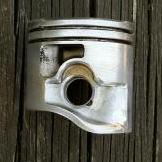Thanks for the comments AJStrees, trigger_andy, openspaceman.
Openspaceman - Interesting observation regarding rivetting technique. ... enlightening even.....
Ok, well the failure happened in an instant, engine revs went skyward that was the first I knew. No half measures - one length of chain rather than a loop.
I used to look at failed bits of engines, searching for clues as to what went first so I'm reasonably in my comfort zone in anslysing the bits. I found fatigue patterns on the preset link which tells me it had a crack in it that was opening (and closing) each load cycle, with crack growing over thousand of cycles. The tie link has pinged, the material was stretched to the point of snapping. The remaining bit of tie strap is a cock-in-a-sock fit on its rivet, this could have happened in the failure but there is no sign of that .
So the conclusion is the preset cracked first, crack grew and finally broke, tie link followed shortly there after. But why?
If the rivetting is done well - so lots of pressure as well as rolling of the head - its likely the pin through the tie link is expanded within the tie link as well...so it takes up any radial clearance between the two parts. No clearance means the tie link can do useful stuff like taking its share of the load in the chain.
Conversely, poor rivetting leaves radial clearance between rivet and tie link, so tie link cant take any load - the preset link does all the work, continually bending back and forth and fatigues.
So the redneck use a hammer for rivetting rather than the pukker rolling tool doesnt seem so bad after all.... 😨😀











